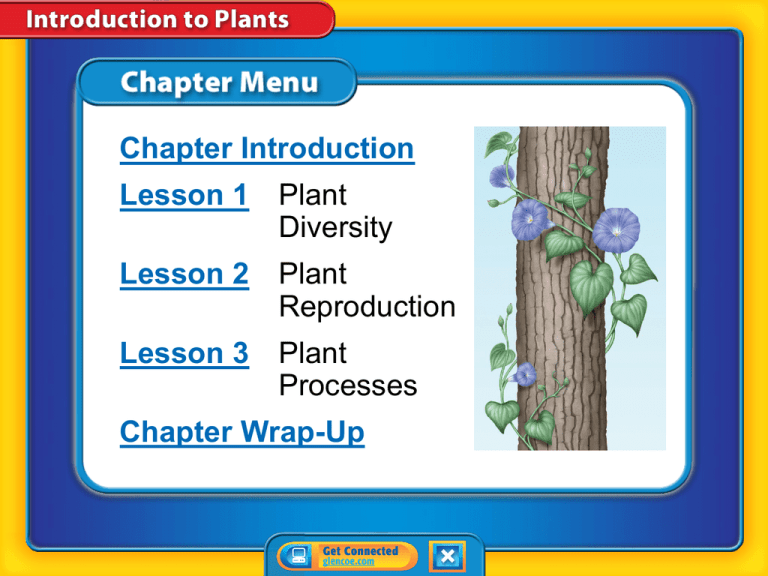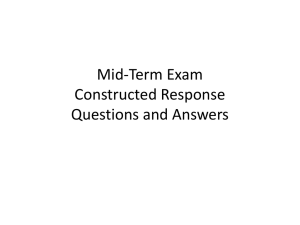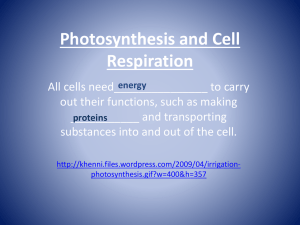
Chapter Introduction
Lesson 1 Plant
Diversity
Lesson 2 Plant
Reproduction
Lesson 3 Plant
Processes
Chapter Wrap-Up
What structures help
ensure the survival of
plants, and what is the
function of each?
What do you think?
Before you begin, decide if you agree or
disagree with each of these statements.
As you view this presentation, see if you
change your mind about any of the
statements.
Do you agree or disagree?
1. Humans could survive without plants.
2. Plant cells contain the same organelles
as animal cells.
3. Plants can reproduce both sexually and
asexually.
4. All plants have a two-stage life cycle.
Do you agree or disagree?
5. Plants respond to their environments.
6. Because plants make their own food,
they do not carry on cellular respiration.
Plant Diversity
• How do a plant’s structures ensure its
survival?
• How are the different plant types alike
and different?
Plant Diversity
• rhizoid
• vascular plant
• stoma
• gymnosperm
• nonvascular
plant
• angiosperm
What is a plant?
• A plant is a
multicellular organism
which is capable of
producing its own
food using energy
from the Sun.
• Like all other
organisms, plants are
made up of cells.
Digital Vision/Getty Images
What is a plant? (cont.)
• A plant cell contains chloroplasts, which
are organelles that make food.
• Unlike an animal
cell, a rigid cell wall
surrounds a plant
cell and helps protect
and support it.
• A plant cell also
contains a large
central vacuole.
What is a plant? (cont.)
• Most plants have roots, stems, and
leaves.
• Roots anchor a plant in the soil, enable
it to grow upright, and absorb water
and minerals from the soil.
What is a plant? (cont.)
• Some plants, such as mosses and
hornworts, have rootlike structures
called rhizoids.
• Rhizoids are
structures that
anchor a plant
but do not
transport water
and minerals.
What is a plant? (cont.)
• Stems help support the
leaves and flowers and
have tissues that help
carry water and
minerals to a plant’s
leaves.
• The two main types of
stems are woody stems
and herbaceous stems.
What is a plant? (cont.)
In most plants, leaves are the major sites
for photosynthesis.
What is a plant? (cont.)
• Water vapor,
carbon dioxide,
and oxygen can
pass into and out
of a leaf through stomata.
Dr. Gerald Van Dyke/Visuals Unlimited/Getty Images
• The stomata are small
openings in the surfaces
of most plant leaves.
What is a plant? (cont.)
How do plant structures such
as roots, stems, and leaves
ensure a plant’s survival?
Nonvascular Plants
• Plants that lack specialized tissues for
transporting water and nutrients are
nonvascular plants.
• The divisions of nonvascular plants
include mosses, liverworts, and
hornworts.
Vascular Seedless Plants
• Vascular plants have specialized
tissues, called vascular tissues, that
transport water and nutrients throughout
the plant.
• Vascular seedless plants include ferns,
horsetails, and club mosses.
Vascular Seed Plants
• Scientists organize vascular seed plants
into two groups—those that produce
flowers and those that do not.
• Gymnosperms are plants that produce
seeds that are not part of a fruit.
Vascular Seed Plants (cont.)
gymnosperm
from French gymnosperme,
means “naked seed”
Vascular Seed Plants (cont.)
• The most common gymnosperms are
conifers.
• Conifers are usually
evergreen, meaning they
stay green all year.
• They have needlelike
or scalelike leaves
and most produce
cones.
Siede Preis/Getty Images
What is a plant? (cont.)
How are the different plant
types alike and different?
• Unlike animal cells, a plant cell has a
rigid cell wall, chloroplasts, and a large
central vacuole.
• Plants have structures that help ensure
their survival.
• Vascular plants have specialized
tissues for transporting water and
nutrients.
What part of a plant anchors to the
terrain, enabling it to grow upright
and absorb water and minerals?
A. leaves
B. roots
C. stems
D. stomata
What type of plants lack
specialized tissues for
transporting water and nutrients?
A. club mosses
B. nonvascular plants
C. rhizoids
D. vascular plants
What are the small openings on
the surfaces of most plant leaves?
A. rhizoids
B. roots
C. stems
D. stomata
Do you agree or disagree?
1. Humans could survive without plants.
2. Plant cells contain the same organelles
as animal cells.
Plant Reproduction
• How do asexual and sexual
reproduction in plants compare and
contrast?
• What are the differences between the
life cycles of seedless and seed
plants?
Plant Reproduction
• pollination
• dormancy
• pistil
• stamen
Asexual Reproduction
• Asexual reproduction occurs when only
one parent organism or part of that
organism produces a new organism.
• The new organism is genetically identical
to the parent.
Sexual Reproduction
• During sexual reproduction, fertilization
occurs when a sperm and an egg join,
combining their genetic material.
• Sexual reproduction produces individuals
that have a different genetic makeup
than the parent organism or organisms.
• Both seedless plants and seed plants
can reproduce sexually.
Sexual Reproduction (cont.)
How do asexual and sexual
reproduction in plants compare
and contrast?
Plant Life Cycles
• The two stages in the life cycle of every
plant are the gametophyte stage and the
sporophyte stage.
• The gametophyte stage begins with a
spore, or haploid cell.
• Through mitosis and cell division, the
spore produces a plant structure or an
entire plant called a gametophyte.
Plant Life Cycles (cont.)
• When a male and
a female sex cell
combine, fertilization
occurs and a
diploid cell forms.
• That diploid cell is
the beginning of the sporophyte stage.
• This cell divides through mitosis and cell
division and forms the sporophyte.
In seedless plants, spores are produced by
the sporophyte.
Plant Life Cycles (cont.)
• Seed plants produce pollen grains, which
contain sperm, and female structures,
which contain one or more eggs.
• The process that occurs when pollen
grains land on a female plant structure
of a plant of the same species is
pollination.
• If a sperm from a pollen grain joins with
an egg, this is called fertilization.
Plant Life Cycles (cont.)
• The embryo is the beginning of the
sporophyte stage of seed plants.
• The embryo and its food supply are
enclosed within a protective coat,
forming a seed.
• In most seed plants, the seed will go
through dormancy, which is a period of
no growth.
Plant Life Cycles (cont.)
• Most flowers have four main structures:
petals, sepals, pistil, and stamen.
• The petals might be brightly colored to
attract insect or animal pollinators.
• The sepals are usually located beneath
the petals and help protect the flower
when it is a bud.
Plant Life Cycles (cont.)
• The female reproductive organ of a
flower is the pistil.
• The stamen is the male reproductive
organ of a flower.
Plant Life Cycles (cont.)
pistil
from French pistil, means
“female organ of a flower”
The life cycle of a flowering plant includes
both gametophyte and sporophyte stages.
Plant Life Cycles (cont.)
What are the differences
between life cycles of seedless
and seed plants?
Plant Life Cycles (cont.)
• Plants that grow from a seed and
produce flowers in one growing season
are called annuals.
• Plants that take two growing seasons to
produce flowers are known as biennials.
• Perennials are plants that grow and bud
for many years.
• There are two stages in the life cycle
of every plant—the gametophyte
stage and the sporophyte stage.
• Annuals, biennials, and perennials
are the different growth cycles of
plants.
• Most seed plants
produce flowers.
What type of reproduction
produces individuals that have a
different genetic makeup than the
parent organism or organisms?
A.
B.
C.
D.
asexual reproduction
fertilization
pollination
sexual reproduction
What is a period of no growth for
the seed of most seed plants?
A. asexual reproduction
B. dormancy
C. fertilization
D. pollination
What type of plant takes two
growing seasons to produce
flowers?
A. annual
B. biennial
C. perennial
D. pistil
Do you agree or disagree?
3. Plants can reproduce both sexually
and asexually.
4. All plants have a two-stage life cycle.
Plant Processes
• What is the relationship between
photosynthesis and cellular respiration?
• How do water and minerals move in
vascular and nonvascular plants?
• How do plants respond to
environmental changes?
Plant Processes
• transpiration
• stimulus
• tropism
Photosynthesis and Cellular
Respiration
• Plants absorb light energy from the Sun
and convert it into chemical energy in a
process called photosynthesis.
• During photosynthesis, a plant produces
sugar that it uses as food.
• Cellular respiration is the process of
releasing energy by breaking down food.
Photosynthesis and Cellular
Respiration (cont.)
What is the relationship
between photosynthesis and
celllular respiration?
Photosynthesis and Cellular
Respiration (cont.)
• Photosynthesis occurs inside organelles
called chloroplasts.
• Chloroplasts contain chlorophyll, a green
pigment that absorbs light energy.
• That energy splits apart water molecules
into hydrogen atoms and oxygen atoms.
Photosynthesis and Cellular
Respiration (cont.)
• Some of the oxygen leaves the plant
through the stomata.
• Carbon dioxide combines with the
hydrogen atoms and forms glucose,
a type of sugar.
• A plant can store sugars, and it uses
some of the oxygen in another process
called cellular respiration.
Photosynthesis and Cellular
Respiration (cont.)
Photosynthesis can be shown by the
following equation:
Photosynthesis and Cellular
Respiration (cont.)
• The process of cellular respiration
breaks down the glucose produced
during photosynthesis and releases the
sugar’s energy.
• Cellular respiration occurs in the
cytoplasm and mitochondria.
Photosynthesis and Cellular
Respiration (cont.)
The equation for cellular respiration is as
follows:
Photosynthesis and Cellular
Respiration (cont.)
• Cellular processes such as growth,
repair, and reproduction all use ATP.
• Plants and some other organisms can
use the waste products of cellular
respiration—carbon dioxide and water—
to make more glucose through
photosynthesis.
Movement of Nutrients and Water
• In order to carry on photosynthesis and
cellular respiration, water and nutrients
must move inside plants.
• This movement or transport of materials
occurs through diffusion and osmosis in
nonvascular plants.
• In vascular plants, water and nutrients
move inside specialized vascular
tissues.
Movement of Nutrients and Water (cont.)
• Roots of plants absorb water and
nutrients from the soil.
• Nutrients from the soil, such as minerals,
are used for making many of the
compounds needed for cell growth and
maintenance.
Movement of Nutrients and Water (cont.)
Transpiration is the release of water
vapor from stomata in leaves.
Movement of Nutrients and Water (cont.)
How do water and nutrients
move in a nonvascular plant?
In a vascular plant?
Plant Responses
• Stimuli are any changes in an
organism’s environment that cause a
response.
• External stimuli include light, touch, and
gravity.
• Internal stimuli, called hormones, are
produced inside a plant and can affect
growth, seed germination, or fruit
ripening.
Plant Responses (cont.)
• Plant growth toward or away from an
external stimulus is called tropism.
• When a plant grows toward
a light source, it is called
positive phototropism.
• A plant’s response to
gravity is called gravitropism.
• A plant’s response to touch is called
thigmotropism.
Plant Responses (cont.)
tropism
from Greek tropos, means
“a turn, change”
Plant Responses (cont.)
How do plants respond to
environmental changes?
• Plants make sugar through the
process of photosynthesis. Plants
break down sugar into usable energy
through the process of cellular
respiration.
• All plants must be
able to transport
water and minerals
in order to survive.
• Plants respond to
internal and external stimuli.
What process breaks down
glucose and releases sugar’s
energy?
A. cellular respiration
B. photosynthesis
C. pollination
D. transpiration
What term describes stimuli that
includes light, touch, and gravity?
A. external stimuli
B. internal stimuli
C. transpiration
D. tropism
Which term refers to a plant’s
response to touch?
A. gravitropism
B. photosynthesis
C. phototropism
D. thigmotropism
Do you agree or disagree?
5. Plants respond to their environments.
6. Because plants make their own food,
they do not carry on cellular
respiration.
Key Concept Summary
Interactive Concept Map
Chapter Review
Standardized Test Practice
There are many
different types of
plants, but they all
have structures and
functions that help
ensure survival.
Lesson 1: Plant Diversity
• Roots and rhizoids anchor plants. Roots are found on
vascular plants and are able to absorb water and
nutrients. Rhizoids are found on nonvascular plants
and do not absorb water and nutrients. Stems help
support the leaves, and in some cases flowers, of a
plant. Stems help carry water and nutrients throughout
the plant. In most plants, leaves are the major sites for
photosynthesis. In addition to making food, leaves also
are involved in the exchange of gases with the
environment through the stomata.
• Plants are classified into groups called divisions. The
main divisions are nonvascular plants and vascular
plants.
Lesson 2: Plant Reproduction
• Asexual reproduction does not involve sex cells.
Offspring are genetically identical to the parent.
Sexual reproduction involves sex cells and produces
offspring that are not genetically identical to each
other or the parent plant(s).
• The life cycles of seedless
and seed plants both contain
a gametophyte and a
sporophyte stage. Seed
plants produce seeds,
and seedless plants
produce spores.
Lesson 3: Plant Processes
• Plants produce sugar through photosynthesis. Cellular
respiration is the process by which organisms break
down the sugar into smaller high energy molecules,
or ATP. ATP is used for life processes.
• Water and nutrients move by
osmosis and diffusion in
nonvascular plants. These
substances are transported
through vascular tissue in
vascular plants.
• Plants respond to stimuli in their environment. Growth
toward or away from a stimulus is called a tropism.
What are structures that anchor a
plant without transport tissue to a
surface?
A. pistils
B. rhizoids
C. seeds
D. stomata
Which plant part is the major site
for photosynthesis?
A. stomata
B. stems
C. roots
D. leaves
What occurs when pollen grains
land on a female plant structure
of a plant in the same species?
A. dormancy
B. fertilization
C. pollination
D. transpiration
Which term refers to the female
reproductive organ of a flower?
A. petal
B. pistil
C. sepal
D. stamen
Which term refers to the release
of water vapor from stomata in
leaves?
A. tropism
B. transpiration
C. photosynthesis
D. cellular respiration
What has specialized tissues that
transport water and nutrients
throughout a plant?
A. liverworts
B. mosses
C. nonvascular plants
D. vascular plants
Which term describes plants that
produce seeds that are not part of
a fruit?
A. club mosses
B. gymnosperms
C. rhizoids
D. stomata
What is the beginning of the
sporophyte stage of seed plants?
A. sperm
B. pistil
C. embryo
D. egg
What plants grow from a seed
and produce flowers in one
growing season?
A. stamen
B. pistil
C. perennials
D. annuals
Which describes any changes in
an organism’s environment that
cause a response?
A. photosynthesis
B. stimuli
C. transpiration
D. tropism









